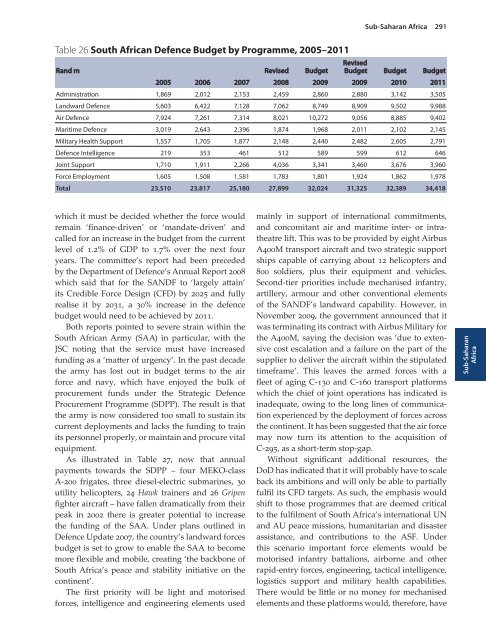Create successful ePaper yourself
Turn your PDF publications into a flip-book with our unique Google optimized e-Paper software.
Table 26 South african defence budget by programme, 2005–2011<br />
rand m revised Budget<br />
which it must be decided whether the force would<br />
remain ‘finance-driven’ or ‘mandate-driven’ and<br />
called for an increase in the budget from the current<br />
level of 1.2% of GDP to 1.7% over the next four<br />
years. The committee’s report had been preceded<br />
by the Department of Defence’s Annual Report 2008<br />
which said that for the SANDF to ‘largely attain’<br />
its Credible Force Design (CFD) by 2025 and fully<br />
realise it by 2031, a 30% increase in the defence<br />
budget would need to be achieved by 2011.<br />
Both reports pointed to severe strain within the<br />
South African Army (SAA) in particular, with the<br />
JSC noting that the service must have increased<br />
funding as a ‘matter of urgency’. In the past decade<br />
the army has lost out in budget terms to the air<br />
force and navy, which have enjoyed the bulk of<br />
procurement funds under the Strategic Defence<br />
Procurement Programme (SDPP). The result is that<br />
the army is now considered too small to sustain its<br />
current deployments and lacks the funding to train<br />
its personnel properly, or maintain and procure vital<br />
equipment.<br />
As illustrated in Table 27, now that annual<br />
payments towards the SDPP – four MEKO-class<br />
A-200 frigates, three diesel-electric submarines, 30<br />
utility helicopters, 24 Hawk trainers and 26 Gripen<br />
fighter aircraft – have fallen dramatically from their<br />
peak in 2002 there is greater potential to increase<br />
the funding of the SAA. Under plans outlined in<br />
Defence Update 2007, the country’s landward forces<br />
budget is set to grow to enable the SAA to become<br />
more flexible and mobile, creating ‘the backbone of<br />
South Africa’s peace and stability initiative on the<br />
continent’.<br />
The first priority will be light and motorised<br />
forces, intelligence and engineering elements used<br />
Sub-Saharan Africa<br />
291<br />
revised<br />
Budget Budget Budget<br />
2005 2006 2007 2008 2009 2009 2010 2011<br />
Administration 1,869 2,012 2,153 2,459 2,860 2,880 3,142 3,505<br />
Landward Defence 5,603 6,422 7,128 7,062 8,749 8,909 9,502 9,988<br />
Air Defence 7,924 7,261 7,314 8,021 10,272 9,056 8,885 9,402<br />
Maritime Defence 3,019 2,643 2,396 1,874 1,968 2,011 2,102 2,145<br />
Military Health Support 1,557 1,705 1,877 2,148 2,440 2,482 2,605 2,791<br />
Defence Intelligence 219 353 461 512 589 599 612 646<br />
Joint Support 1,710 1,911 2,266 4,036 3,341 3,460 3,676 3,960<br />
Force Employment 1,605 1,508 1,581 1,783 1,801 1,924 1,862 1,978<br />
Total 23,510 23,817 25,180 27,899 32,024 31,325 32,389 34,418<br />
mainly in support of international commitments,<br />
and concomitant air and maritime inter- or intratheatre<br />
lift. This was to be provided by eight Airbus<br />
A400M transport aircraft and two strategic support<br />
ships capable of carrying about 12 helicopters and<br />
800 soldiers, plus their equipment and vehicles.<br />
Second-tier priorities include mechanised infantry,<br />
artillery, armour and other conventional elements<br />
of the SANDF’s landward capability. However, in<br />
November 2009, the government announced that it<br />
was terminating its contract with Airbus Military for<br />
the A400M, saying the decision was ‘due to extensive<br />
cost escalation and a failure on the part of the<br />
supplier to deliver the aircraft within the stipulated<br />
timeframe’. This leaves the armed forces with a<br />
fleet of aging C-130 and C-160 transport platforms<br />
which the chief of joint operations has indicated is<br />
inadequate, owing to the long lines of communication<br />
experienced by the deployment of forces across<br />
the continent. It has been suggested that the air force<br />
may now turn its attention to the acquisition of<br />
C-295, as a short-term stop-gap.<br />
Without significant additional resources, the<br />
DoD has indicated that it will probably have to scale<br />
back its ambitions and will only be able to partially<br />
fulfil its CFD targets. As such, the emphasis would<br />
shift to those programmes that are deemed critical<br />
to the fulfilment of South Africa’s international UN<br />
and AU peace missions, humanitarian and disaster<br />
assistance, and contributions to the ASF. Under<br />
this scenario important force elements would be<br />
motorised infantry battalions, airborne and other<br />
rapid-entry forces, engineering, tactical intelligence,<br />
logistics support and military health capabilities.<br />
There would be little or no money for mechanised<br />
elements and these platforms would, therefore, have<br />
Sub-Saharan<br />
Africa


